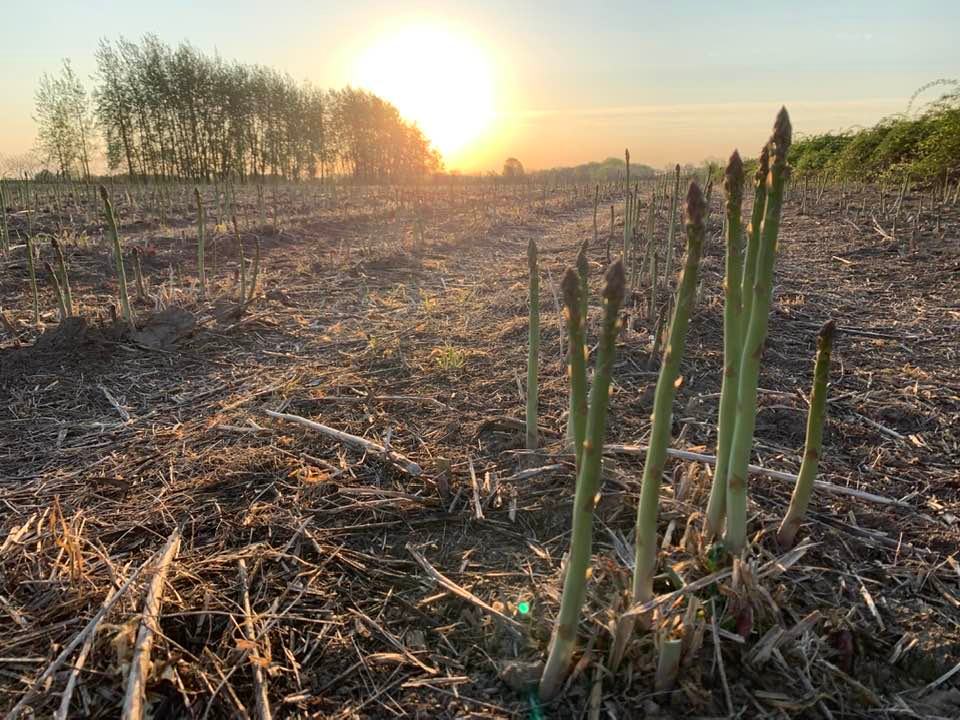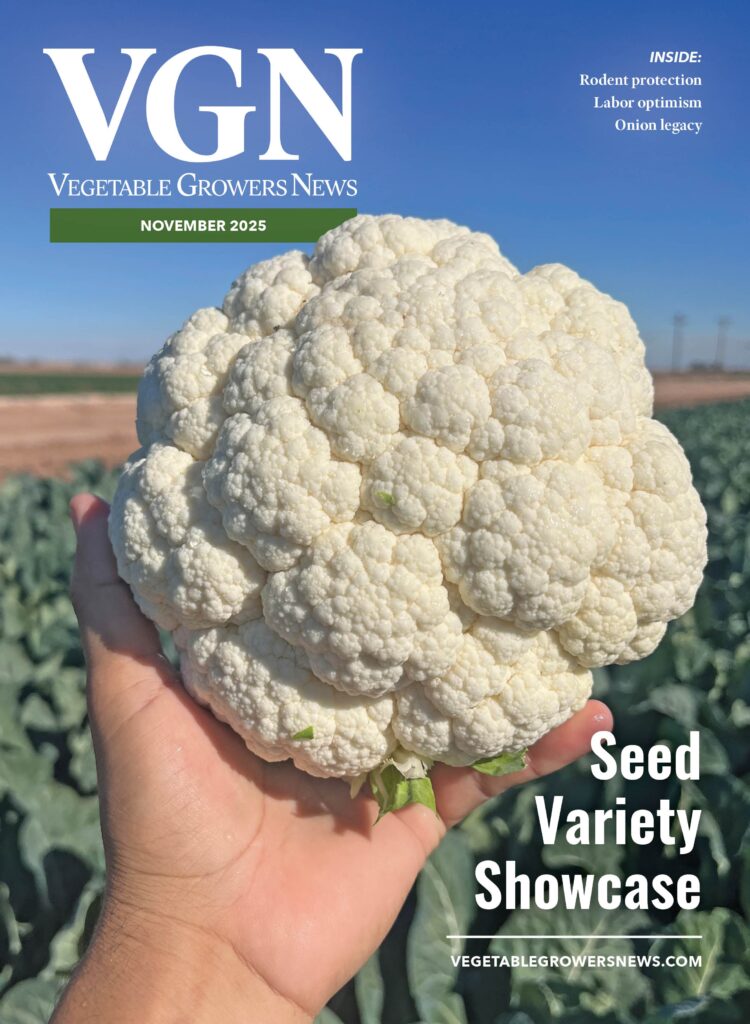
Sep 23, 2025Golden Stock Farms’ asparagus success
Growing asparagus is notoriously challenging, but that hasn’t stopped Golden Stock Farms.
Located on the west side of Michigan’s Lower Peninsula, the fourth-generation family farm has found success cultivating the crop in Oceana County, one of the country’s leading asparagus regions.
“Asparagus is unlike any other crop, and it has to be managed very closely every day to decide when you need to harvest and for which market it needs to be harvested,” said Mary Sheppard, field manager and agronomist/certified crop adviser. “It’s a challenging commodity to be involved in. As with any crop, so much is out of our control. The biggest challenges with asparagus are the labor to harvest it (expensive) and the day-to-day management of harvest.”
Asparagus is a highly finicky crop that likes particular weather. If it’s too cold, it won’t grow and will contract purple spot. If it’s too hot, it grows too fast and the heads start to seed out. The daily harvest timing makes for an intense hands-on experience growing for Golden Stock’s three markets: fresh, frozen, and culs and tips (frozen/canned).

Variety tradition
Millennium, the region’s longtime standard variety, is Golden Stock’s leading variety, but the farm also grows some Eclipse and Sequoia. While Millennium remains a strong performer, its biggest drawback is it produces “the glut” — a sudden surge of spears — about 10 days into the season.
Because everyone in the region plants Millennium, it produces an oversupply that’s difficult to market through the sales pipeline, Sheppard said. A variety comparable to Millennium but one that produces steadily throughout the season would help growers, she said
Depression-era roots
Golden Stock’s roots trace to 1932, when Walter Walsworth started a dairy farm before transitioning to beef cattle, then eventually adding asparagus, alfalfa and row crops. In the early 2000s, the farm exited the cattle business — the original source of the farm’s name — and turned its focus to asparagus.
Walter’s son Dick took over the farm, followed by his grandson Ryan. Today, Janice Walsworth, Ryan’s wife, is the owner, and their son Jordon Walsworth is fourth generation who runs the day-to-day operations.
The unexpected deaths of Ryan in 2017 and Dick in 2019 led to a serious learning curve and reliance on the knowledge Dick instilled in his offspring, Janice said.
Hard work and determination are keys to the company’s success, she said.
“Farming is such a challenging and rewarding job,” Janice said. “We strive to keep up on new technology, techniques and new plant varieties. Through trial and error, we keep moving forward.”

Tech issues
Technological adoption has become important.
“When you think of how Walt farmed with horses, and now we are working the ground with tractors equipped with GPS, it’s crazy to think about,” Janice said. “The most important thing Dick taught us was respect — respect the land and respect your neighbors. Be a good person and do your best. He truly left a legacy.”
Because labor accounts for half of asparagus’ per-pound input costs, Sheppard said there has been much talk, interest and research into mechanical harvesting. It’s been a difficult problem to solve, but multiple companies are working on it, she said.
Seeking more vertical integration and efficiencies, Golden Stock in 2022 installed a hydrocooler. The hydrocooler helped the farm become vertically integrated and saved it money by cooling its asparagus in-house.
“We are always looking for ways to become more efficient,” Sheppard said. “To be a farmer, you have to be a smart business person now more than ever before. You can’t be afraid to make a change if it makes sense.”

Soil, cover crop pioneer
Like Dick, Sheppard is passionate about conservation. In a 1977 Oceana Soil & Water Conservation annual report, Dick was quoted as saying “What’s good for the land … is good for me.”
In 1972, Dick pioneered growing asparagus utilizing no-till management. In the early 1980s, he was an early adopter of using cover crops in asparagus to manage wind erosion. Other conservation practices included creating shallow ponds for wildlife, grassed waterways, windbreaks and crop rotation, the latter practice Dick learned from his father.
Sheppard serves on her county conservation district board and is proud to work on a farm that, in 2022, was one of the first to earn Michigan Agriculture Environmental Assurance Program (MAEAP) certification. Golden Stock has maintained the certification, reflecting the farm’s passion for conservation.
“We live in such a beautiful area with our lakes and woods and farmland, and it is our duty to preserve it for the next generation,” Sheppard said. “If you take care of your land, it will, in turn, grow a better crop and make you more profitable. It is one of the most worthwhile investments there is.”

Crop rotation
Crop rotation is important to minimize soilborne disease and allows for application of different herbicides that can reduce herbicide-resistant weeds. Because asparagus is a perennial crop, fields remain in production for 15 to 20 years. Once a field comes out of asparagus, it goes into rye for several years, then corn for a couple of years and oats the year before asparagus returns. Oats are planted as cover crops because they harvest early and allow for fall fumigation. Golden Stock waits a minimum of five years before replanting asparagus.
Rye cover cropping helps prevent erosion in the region’s sandy soils, decreases nutrient loss and helps build organic matter levels. Golden Stock also applies hog and turkey manure followed by a cover crop to maintain those nutrients through the winter.
“We pull soil samples every other year and make sure we are on top of our soil fertility levels,” Sheppard said. “With the sandy soils we have, there is a lot of spoon-feeding of nutrients that goes on.”
Asparagus beetle is the major pest concern, while purple spot is the leading disease threat. Beetle eggs defoliate ferns, which weakens plants for the next season. Purple spot, a fungal infection, causes cosmetic issues on spears during prolonged periods of cool, wet weather.
Golden Stock controls beetles with Carbaryl insecticide and by chopping dead ferns in fall and spring during overwintering. A timely fern spray schedule manages purple spot.

Weed battle
As no-till has controlled erosion in Oceana County asparagus since the 1970s, weed control is a big challenge. With limited investment from chemical companies in new pesticide research and labeling, asparagus growers have relied on the same chemistries for 30 years, resulting in resistance issues.
Palmer amaranth (pigweed) is Golden Stock’s most difficult weed. After first-year asparagus plantings, fields are manually hoed several times during the first summer, followed by a mixture of herbicides applied pre- and postharvest to manage weeds.
Sheppard, who was crowned the 2016 National Asparagus Queen, says she loves the freedom of working outdoors with her hands.
“At this point in my life, I don’t think I could ever work a 9-to-5,” she said. “It’s extremely rewarding to me. There is something about the excitement and absolute chaos of the six weeks of asparagus harvest that is exhilarating. If you’ve never been a part of it, you wouldn’t understand. It’s unlike any other crop.”
Doug Ohlemeier, Assistant Editor
















